Vcds Backup Settings are vital in modern car coding because of the complexity of today’s automotive systems; securing them is crucial before any modifications. CAR-CODING.EDU.VN provides expert remote assistance to ensure safe and effective coding operations. Get support from specialized technicians, ECU programmers, and feature activation specialists.
Contents
- 1. What are VCDS Backup Settings and Why are They Important?
- 2. What Car Settings Can VCDS Backup?
- 3. How to Backup Long Coding with VCDS?
- 4. What Does Long Coding Information Look Like in an Auto Scan?
- 5. How to Backup Adaptation Channels with VCDS?
- 6. How Do LIN or Slave Modules Fit Into the Backup Process?
- 7. How Long Does a Complete VCDS Backup Take?
- 8. What Precautions Should I Take During a VCDS Backup?
- 9. Where Are VCDS Backup Files Stored?
- 10. Why Might I Need Professional Assistance with VCDS Backup Settings?
- 10.1. What Kind of Support Does CAR-CODING.EDU.VN Offer for VCDS?
- 10.2. What Coding Challenges Can CAR-CODING.EDU.VN Address?
- 10.3. How Can Remote Support Improve Coding Outcomes?
- 10.4. What Types of Vehicles Does CAR-CODING.EDU.VN Support?
- 10.5. How Does CAR-CODING.EDU.VN Ensure the Safety of Coding Modifications?
- 10.6. What Equipment Is Needed for Remote VCDS Support?
- 10.7. How Quickly Can I Get Remote Coding Assistance?
- 10.8. What Are the Costs Associated with Remote VCDS Support?
- 10.9. How Do I Get Started with CAR-CODING.EDU.VN Remote Support?
- 10.10. Can CAR-CODING.EDU.VN Help with Activating Hidden Features?
- 11. What Are Common Coding Mistakes and How to Avoid Them?
- 12. How Can I Verify That My VCDS Backup Is Valid?
- 13. What Are the Ethical Considerations When Coding Vehicles?
- 14. What Are Some Advanced VCDS Coding Techniques?
- 15. How Does VCDS Integrate with Other Diagnostic Tools?
- 16. What Future Trends Are Expected in VCDS Coding?
- 17. How to Use VCDS to Customize Your Car Lighting?
- 18. How Does VCDS Help in Diagnosing Electrical Issues?
- 19. What Is the Role of VCDS in Optimizing Fuel Efficiency?
- 20. How Does VCDS Support Vehicle Security and Anti-Theft Systems?
- 21. How Does VCDS Facilitate ECU Cloning?
- 22. What Role Does VCDS Play in DPF Regeneration?
- 23. Can VCDS Be Used to Adjust Air Suspension Settings?
- 24. How to Perform a Throttle Body Alignment with VCDS?
- 25. How Does VCDS Help with Brake System Maintenance?
1. What are VCDS Backup Settings and Why are They Important?
VCDS backup settings refer to creating a safeguard of your vehicle’s current software configurations using the Ross-Tech VCDS (Vag-Com Diagnostic System) tool. This process is essential because it allows you to revert to the original settings if any issues arise during coding, adaptations, or other modifications.
Backing up your VCDS settings is critical for several reasons:
- Safety Net: Provides a reliable way to undo changes if something goes wrong.
- Error Recovery: Allows for quick restoration of original settings after an error.
- Risk Mitigation: Minimizes the risk of causing irreversible damage during modifications.
- Confidence: Gives you the confidence to experiment with coding changes safely.
- Documentation: Serves as a record of the vehicle’s original configuration.
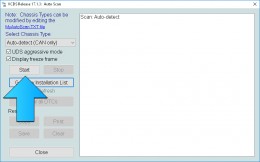 VCDS Main Screen
VCDS Main Screen
2. What Car Settings Can VCDS Backup?
VCDS can backup various car settings, including long coding, adaptations, and module-specific configurations. Each of these settings plays a crucial role in how your vehicle operates.
- Long Coding: This involves the primary coding settings for each control module.
- Adaptations: These are fine-tuning settings that adjust the behavior of specific functions.
- Module-Specific Settings: Each module has unique parameters that can be backed up and restored.
3. How to Backup Long Coding with VCDS?
Backing up long coding with VCDS involves performing an auto scan of your vehicle and saving the resulting log file. This file contains the long coding information for all modules in your car.
Here are the steps to backup long coding:
- Connect VCDS: Connect your VCDS interface to your vehicle’s OBD-II port and turn on the ignition.
- Open VCDS Software: Launch the Ross-Tech VCDS software on your computer.
- Auto Scan: From the main screen, click the “Auto Scan” button.
 VCDS Main Screen
VCDS Main Screen
- Start Scanning: Select your vehicle’s chassis type if prompted, and then click the “Start” button to begin the auto scan.
- Save Log File: Once the scan is complete, click the “Save” button to save the log file to your computer.
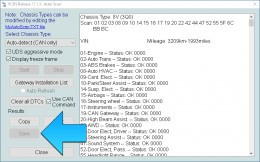 VCDS Save Option
VCDS Save Option
- Name the File: Give the file a meaningful name (e.g., “OriginalCoding_Date”) and save it in a safe location.
4. What Does Long Coding Information Look Like in an Auto Scan?
Long coding information in an auto scan is displayed within the control module details. It typically consists of a long string of alphanumeric characters representing the module’s configuration.
Control module information within an auto scan breaks down as follows:
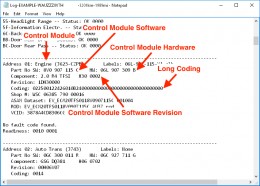 Control Module Information
Control Module Information
- Module Address: The specific address of the control module (e.g., 01-Engine).
- Component: A description of the module’s function (e.g., 1.8TSI MED17.5.10).
- Software Coding: The long coding string (e.g., 0104010A190F00200000).
5. How to Backup Adaptation Channels with VCDS?
Backing up adaptation channels involves creating adaptation channel maps for each module in your vehicle. This process saves the current values of all adaptation channels in a CSV file.
Here’s how to backup adaptation channels:
- Open VCDS Software: Launch the Ross-Tech VCDS software on your computer.
- Select Applications: From the main screen, click the “Applications” button.
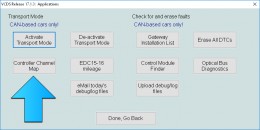 VCDS Main Screen
VCDS Main Screen
- Controller Channel Map: Select “Controller Channel Map” in the Applications screen.
- Enter Module Address: In the “Maps” box, enter the address of the module you want to backup (e.g., “01” for Engine).
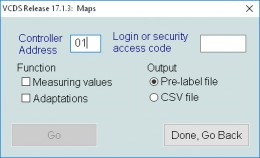 VCDS Controller Channel Map
VCDS Controller Channel Map
- Select Adaptations: Under “Function”, select “Adaptations”.
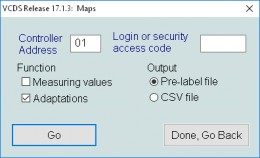 VCDS Adaptations
VCDS Adaptations
- Select CSV File: Under “Output”, select “CSV File”.
- Start Extraction: Click “Go” to start extracting the adaptation channels.
- Save CSV File: The CSV file will be saved in the default VCDS logs folder (C:Ross-TechVCDSLogs).
Repeat this process for each module listed in your auto scan to ensure a complete backup.
6. How Do LIN or Slave Modules Fit Into the Backup Process?
LIN (Local Interconnect Network) or slave modules do not appear in the control module selection screen. Their coding is included within your vehicle’s auto scan.
To backup the coding for these modules:
- Access Master Module: Access the long coding screen of the master control module.
- Select Slave Module: Use the dropdown menu to select the specific LIN/slave module.
- Screen Capture: Take screenshots of the bytes and bits displayed for the selected module.
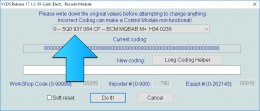 VCDS LIN Modules
VCDS LIN Modules
7. How Long Does a Complete VCDS Backup Take?
The time required for a complete VCDS backup can vary based on the number of modules in your vehicle and the amount of data each module contains.
- Basic Backup: A basic backup might take around one to one and a half hours.
- Extensive Backup: If your vehicle has many modules, it could take up to two hours or more.
It’s advisable to set aside enough time and ensure your vehicle is connected to a battery charger to avoid draining the battery during the process.
8. What Precautions Should I Take During a VCDS Backup?
Several precautions should be taken during a VCDS backup to ensure the process goes smoothly and without issues.
- Battery Maintenance: Connect your vehicle to a battery charger to prevent the battery from draining.
- Stable Connection: Ensure a stable connection between the VCDS interface and your vehicle.
- Close Doors: Make sure all vehicle doors are closed (but not locked).
- Avoid Interruptions: Minimize any interruptions during the backup process.
- Latest Software: Use the latest version of Ross-Tech VCDS software.
9. Where Are VCDS Backup Files Stored?
By default, VCDS backup files are stored in the following directory:
C:Ross-TechVCDSLogs
It’s recommended to create a separate folder within this directory to store your backup files and keep them organized.
10. Why Might I Need Professional Assistance with VCDS Backup Settings?
Professional assistance with VCDS backup settings may be needed due to the complexity of modern vehicle systems and the potential risks involved in coding and modifications.
Here are several reasons why you might need expert help:
- Complexity: Modern vehicle systems are increasingly complex, making it difficult for non-experts to navigate coding options.
- Risk of Damage: Incorrect coding can lead to serious malfunctions or even damage to the vehicle’s control units.
- Time Savings: Professionals can perform backups and modifications more efficiently, saving you time and effort.
- Expert Knowledge: Experts have in-depth knowledge of vehicle systems and coding procedures, ensuring accurate and safe modifications.
- Troubleshooting: Professionals can quickly identify and resolve any issues that may arise during the backup or modification process.
10.1. What Kind of Support Does CAR-CODING.EDU.VN Offer for VCDS?
CAR-CODING.EDU.VN provides comprehensive remote assistance for VCDS, ensuring technicians and shop owners can confidently navigate complex coding tasks. Our services include:
- Remote Coding Support: Real-time assistance for coding and programming tasks.
- ECU Programming: Expert programming services for various vehicle control units.
- Feature Activation: Guidance on activating hidden features and customizing vehicle settings.
- Fault Code Clearing: Support for clearing persistent fault codes and resolving diagnostic issues.
- Technical Guidance: Step-by-step instructions and expert advice on using VCDS effectively.
10.2. What Coding Challenges Can CAR-CODING.EDU.VN Address?
CAR-CODING.EDU.VN helps overcome numerous coding challenges, ensuring efficient and effective solutions. Some common challenges we address include:
- Complex Coding Procedures: Simplifying intricate coding processes with expert guidance.
- Risk Mitigation: Ensuring safe coding practices to prevent damage to vehicle systems.
- Software and Tool Updates: Keeping up-to-date with the latest coding tools and software versions.
- Error Resolution: Quickly resolving coding errors and restoring vehicle functionality.
- Feature Activation: Enabling hidden features to enhance vehicle performance and convenience.
10.3. How Can Remote Support Improve Coding Outcomes?
Remote support from CAR-CODING.EDU.VN significantly improves coding outcomes by providing expert guidance and real-time assistance. The benefits include:
- Accuracy: Ensuring precise coding and programming to avoid errors.
- Efficiency: Streamlining the coding process to save time and effort.
- Safety: Implementing safe coding practices to protect vehicle systems.
- Problem Solving: Quickly addressing and resolving any coding issues that arise.
- Customization: Tailoring vehicle settings to meet specific customer preferences.
10.4. What Types of Vehicles Does CAR-CODING.EDU.VN Support?
CAR-CODING.EDU.VN supports a wide range of vehicle makes and models, including Audi, Volkswagen, BMW, Mercedes-Benz, and more. Our expertise covers various vehicle systems, including:
- Engine Control Units (ECU)
- Transmission Control Units (TCU)
- Anti-lock Braking Systems (ABS)
- Airbag Systems
- Infotainment Systems
- Comfort and Convenience Systems
10.5. How Does CAR-CODING.EDU.VN Ensure the Safety of Coding Modifications?
CAR-CODING.EDU.VN ensures the safety of coding modifications through rigorous protocols and expert oversight. Our safety measures include:
- Backup Procedures: Always creating a complete backup of the vehicle’s original settings before any modifications.
- Validated Procedures: Using validated coding procedures and best practices.
- Expert Monitoring: Continuously monitoring the coding process to identify and address any potential issues.
- Quality Control: Implementing thorough quality control checks to verify the accuracy and reliability of coding changes.
- Remote Support: Providing remote support to guide technicians through the coding process and ensure safe execution.
10.6. What Equipment Is Needed for Remote VCDS Support?
To receive remote VCDS support from CAR-CODING.EDU.VN, you will need the following equipment:
- VCDS Interface: A genuine Ross-Tech VCDS interface cable.
- Laptop: A laptop with the Ross-Tech VCDS software installed.
- Internet Connection: A stable internet connection for remote access.
- Remote Access Software: Software such as TeamViewer or AnyDesk for remote screen sharing.
- Battery Charger: A battery charger to maintain vehicle battery voltage during coding.
10.7. How Quickly Can I Get Remote Coding Assistance?
CAR-CODING.EDU.VN offers prompt remote coding assistance to minimize downtime and ensure efficient service. Our typical response times are:
- Immediate Support: For urgent issues, we offer immediate support to address critical coding problems.
- Scheduled Appointments: For routine coding tasks, we offer scheduled appointments to ensure timely assistance.
- Flexible Availability: Our services are available during flexible hours to accommodate various time zones and schedules.
10.8. What Are the Costs Associated with Remote VCDS Support?
The costs associated with remote VCDS support from CAR-CODING.EDU.VN vary based on the complexity of the coding task and the time required. We offer transparent pricing with no hidden fees. Our pricing structure includes:
- Hourly Rates: Competitive hourly rates for remote coding assistance.
- Project-Based Pricing: Fixed pricing for specific coding projects with clearly defined deliverables.
- Subscription Plans: Discounted subscription plans for frequent users of our remote coding services.
- Custom Quotes: Customized quotes based on the specific needs and requirements of each customer.
10.9. How Do I Get Started with CAR-CODING.EDU.VN Remote Support?
Getting started with CAR-CODING.EDU.VN remote support is easy. Simply follow these steps:
- Contact Us: Reach out to us via our website CAR-CODING.EDU.VN or WhatsApp +1 (641) 206-8880.
- Describe Your Needs: Provide details about the coding task you need assistance with.
- Schedule a Session: Schedule a remote support session at a convenient time.
- Connect Your Equipment: Ensure your VCDS interface, laptop, and internet connection are ready.
- Receive Expert Support: Connect with our expert technician and receive real-time coding assistance.
10.10. Can CAR-CODING.EDU.VN Help with Activating Hidden Features?
Yes, CAR-CODING.EDU.VN specializes in activating hidden features in various vehicle makes and models. Our experts can guide you through the process of enabling features such as:
- Cornering Lights: Activating cornering lights for improved visibility.
- Coming Home/Leaving Home Lights: Enabling automatic headlight activation when entering or exiting the vehicle.
- Gauge Staging: Activating gauge staging for a sporty display on startup.
- Video in Motion: Enabling video playback on the infotainment system while driving (where legal).
- Traffic Sign Recognition: Activating traffic sign recognition to display speed limits and other signs on the dashboard.
11. What Are Common Coding Mistakes and How to Avoid Them?
Several common coding mistakes can lead to issues. Understanding these mistakes and how to avoid them is crucial for safe and successful coding.
Common coding mistakes include:
- Incorrect Module Selection: Selecting the wrong control module for coding changes.
- Invalid Coding Values: Entering incorrect or unsupported coding values.
- Ignoring Backup Procedures: Failing to create a backup of the original settings before making changes.
- Interrupted Coding Process: Interrupting the coding process due to power loss or connection issues.
- Using Incompatible Software: Using outdated or incompatible coding software.
To avoid these mistakes:
- Double-Check Module Selection: Always verify that you have selected the correct control module.
- Consult Coding Guides: Refer to reliable coding guides and resources for accurate coding values.
- Always Backup Settings: Create a complete backup of the original settings before making any changes.
- Ensure Stable Power Supply: Use a battery charger to maintain a stable power supply during coding.
- Use the Latest Software: Keep your coding software up-to-date with the latest version.
- Seek Expert Assistance: When in doubt, seek assistance from experienced coding professionals.
12. How Can I Verify That My VCDS Backup Is Valid?
Verifying the validity of your VCDS backup is essential to ensure that you can successfully restore your vehicle’s settings if needed.
Here’s how to verify your backup:
- Check File Integrity: Ensure that the backup files are not corrupted or damaged.
- Review Log Files: Open the auto scan log file and review the coding information to ensure it is complete and accurate.
- Compare with Original Settings: If possible, compare the backup settings with the original settings documented elsewhere (e.g., screenshots, notes).
- Perform Test Restore: As a test, restore the backup settings to a non-critical module and verify that the changes are applied correctly.
13. What Are the Ethical Considerations When Coding Vehicles?
Coding vehicles involves ethical considerations, especially when modifying safety-related systems or activating features that may not be legal in certain regions.
Ethical considerations include:
- Safety Systems: Avoid modifying safety-critical systems (e.g., airbags, ABS) in a way that could compromise their functionality.
- Legal Compliance: Ensure that any coding changes comply with local laws and regulations.
- Transparency: Be transparent with vehicle owners about the coding changes being made and their potential impact.
- Informed Consent: Obtain informed consent from vehicle owners before making any coding changes.
- Data Privacy: Respect data privacy and avoid accessing or modifying sensitive information without authorization.
14. What Are Some Advanced VCDS Coding Techniques?
Advanced VCDS coding techniques involve more complex modifications and customizations that require a deeper understanding of vehicle systems.
Some advanced techniques include:
- Module Retrofitting: Adding or replacing control modules and coding them to work with the vehicle.
- Performance Tuning: Adjusting engine parameters to improve performance (use caution and follow legal guidelines).
- Custom Feature Development: Creating custom features and functionalities through coding modifications.
- Diagnostic Procedures: Using VCDS to diagnose and troubleshoot complex vehicle issues.
- Data Logging: Recording and analyzing vehicle data to optimize performance and efficiency.
These techniques should only be attempted by experienced professionals with the necessary knowledge and expertise.
15. How Does VCDS Integrate with Other Diagnostic Tools?
VCDS integrates with other diagnostic tools through standard protocols and interfaces, allowing for comprehensive vehicle diagnostics and coding.
Integration methods include:
- OBD-II Compatibility: VCDS is compatible with the OBD-II standard, allowing it to communicate with a wide range of vehicles.
- CAN Bus Communication: VCDS supports CAN (Controller Area Network) bus communication, enabling it to access and modify data in various control modules.
- Diagnostic Protocols: VCDS supports various diagnostic protocols, such as K-line, L-line, and UDS (Unified Diagnostic Services).
- Data Exchange: VCDS can exchange data with other diagnostic tools through standardized file formats and interfaces.
- Remote Diagnostics: VCDS supports remote diagnostics, allowing technicians to access and diagnose vehicles remotely.
16. What Future Trends Are Expected in VCDS Coding?
Several future trends are expected in VCDS coding, driven by advancements in vehicle technology and the increasing complexity of automotive systems.
These trends include:
- Increased Complexity: Coding will become more complex as vehicles incorporate more advanced technologies.
- Cloud-Based Coding: Cloud-based coding platforms will enable remote access and collaboration.
- AI-Powered Coding: AI-powered tools will automate and optimize coding processes.
- Cybersecurity Measures: Enhanced cybersecurity measures will be implemented to protect against unauthorized access and modifications.
- Over-the-Air Updates: Over-the-air (OTA) updates will enable remote software updates and feature enhancements.
17. How to Use VCDS to Customize Your Car Lighting?
VCDS can be used to customize various aspects of your car’s lighting system, allowing you to personalize the appearance and functionality of your vehicle.
Customization options include:
- Daytime Running Lights (DRL): Adjusting the brightness and behavior of DRLs.
- Cornering Lights: Activating or modifying cornering lights for improved visibility.
- Coming Home/Leaving Home Lights: Enabling automatic headlight activation when entering or exiting the vehicle.
- Ambient Lighting: Customizing the color and intensity of interior ambient lighting.
- Brake Lights: Adjusting the behavior of brake lights, such as flashing patterns.
18. How Does VCDS Help in Diagnosing Electrical Issues?
VCDS is a valuable tool for diagnosing electrical issues in vehicles, providing detailed information about fault codes, sensor readings, and system status.
Diagnostic capabilities include:
- Fault Code Reading: Reading and interpreting fault codes to identify electrical problems.
- Live Data Monitoring: Monitoring live data from sensors and actuators to diagnose issues in real-time.
- Component Testing: Performing component tests to verify the functionality of electrical components.
- Wiring Diagrams: Accessing wiring diagrams and schematics to trace electrical circuits.
- System Status Checks: Checking the status of various electrical systems to identify potential problems.
19. What Is the Role of VCDS in Optimizing Fuel Efficiency?
VCDS can play a role in optimizing fuel efficiency by allowing you to monitor and adjust various engine parameters.
Optimization techniques include:
- Monitoring Fuel Consumption: Monitoring fuel consumption data to identify areas for improvement.
- Adjusting Engine Parameters: Adjusting engine parameters such as ignition timing and fuel injection to optimize fuel efficiency (use caution and follow legal guidelines).
- Diagnosing Engine Issues: Diagnosing and resolving engine issues that can affect fuel efficiency.
- Resetting Adaptations: Resetting engine adaptations to allow the engine to relearn optimal settings.
- Data Logging: Recording and analyzing engine data to identify areas for optimization.
20. How Does VCDS Support Vehicle Security and Anti-Theft Systems?
VCDS supports vehicle security and anti-theft systems by allowing you to diagnose and configure various security-related features.
Security features include:
- Immobilizer Coding: Coding and configuring the immobilizer system to prevent unauthorized starting.
- Alarm System Diagnostics: Diagnosing and troubleshooting issues with the alarm system.
- Central Locking System: Configuring and testing the central locking system.
- Key Programming: Programming new keys and remote controls.
- Security System Adaptations: Adjusting security system adaptations to customize security settings.
21. How Does VCDS Facilitate ECU Cloning?
VCDS facilitates ECU cloning by allowing you to read and write data from and to the ECU, which is necessary for duplicating the ECU’s contents.
Here’s how VCDS helps in ECU cloning:
- Reading ECU Data: Using VCDS to read the complete data from the original ECU.
- Saving ECU Data: Saving the data in a file that can be transferred to the new ECU.
- Writing ECU Data: Writing the saved data to the replacement ECU, effectively cloning it.
- Adaptation Support: Helping adapt the cloned ECU to the vehicle, ensuring proper functionality.
Cloning an ECU is a complex procedure that requires precision and expertise. Improper handling can lead to non-functional ECUs and potential vehicle damage.
22. What Role Does VCDS Play in DPF Regeneration?
VCDS is crucial in managing Diesel Particulate Filter (DPF) regeneration, a process necessary to clean the filter of accumulated soot.
VCDS helps in DPF regeneration by:
- Monitoring DPF Status: Providing real-time data on the DPF’s soot accumulation level.
- Initiating Regeneration: Allowing the user to manually initiate a DPF regeneration cycle when necessary.
- Fault Code Diagnostics: Helping diagnose issues that prevent DPF regeneration and providing solutions.
- Adaptation Reset: Resetting adaptation values after replacing or cleaning the DPF.
Proper DPF management ensures the vehicle runs efficiently and meets emission standards, making VCDS an invaluable tool for diesel vehicle maintenance.
23. Can VCDS Be Used to Adjust Air Suspension Settings?
Yes, VCDS can be used to adjust air suspension settings, providing control over vehicle ride height and suspension behavior.
VCDS capabilities for air suspension include:
- Ride Height Adjustment: Adjusting the ride height of the vehicle to achieve the desired stance.
- Adaptation Channels: Modifying adaptation channels to fine-tune suspension settings.
- Leveling System Calibration: Calibrating the air suspension system to ensure proper leveling.
- Fault Code Diagnostics: Diagnosing and resolving issues with the air suspension system.
Adjusting air suspension settings can improve the vehicle’s ride quality and handling, making VCDS an essential tool for customizing luxury vehicles.
24. How to Perform a Throttle Body Alignment with VCDS?
Performing a throttle body alignment with VCDS is essential for ensuring smooth engine operation, especially after cleaning the throttle body.
Steps for throttle body alignment include:
- Connect VCDS: Connect the VCDS interface to the vehicle and start the software.
- Select Engine Module: Choose the engine control module (usually module 01).
- Basic Settings: Navigate to the “Basic Settings” function.
- Throttle Body Alignment: Select the throttle body alignment function (usually group 060 or 098).
- Start Alignment: Initiate the alignment process and wait for it to complete.
A properly aligned throttle body ensures the engine idles correctly and responds smoothly to throttle inputs, enhancing the driving experience.
25. How Does VCDS Help with Brake System Maintenance?
VCDS aids in brake system maintenance by providing functionalities for diagnosing and servicing the braking system.
VCDS support for brake systems includes:
- ABS Diagnostics: Diagnosing issues with the Anti-lock Braking System (ABS) and Traction Control System (TCS).
- Brake Bleeding: Assisting with the brake bleeding process, particularly for vehicles with electronic brake distribution.
- EPB Service: Retracting the Electronic Parking Brake (EPB) for brake pad replacement.
- Sensor Monitoring: Monitoring brake pad wear sensors and other brake-related sensors.
Proper brake system maintenance ensures vehicle safety and performance, making VCDS an essential tool for brake service.
Don’t let complex coding tasks slow you down. Contact CAR-CODING.EDU.VN now for expert remote VCDS support and ensure your coding modifications are safe, efficient, and accurate. Reach us at our U.S. office: 100 Tech Innovation Dr, Suite 500, San Jose, CA 95110, United States, via WhatsApp at +1 (641) 206-8880, or visit our website CAR-CODING.EDU.VN for immediate assistance.